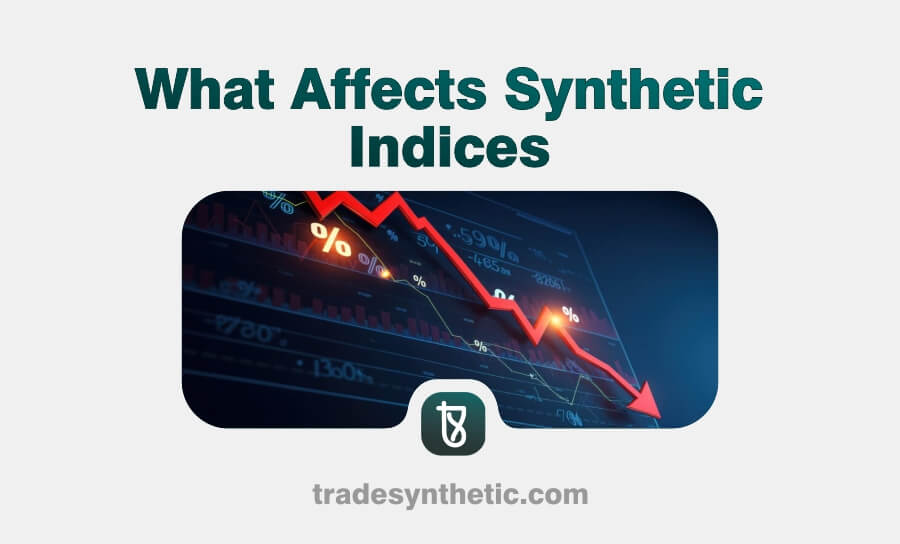Analyzing what affects synthetic indices is crucial. Synthetic indices are special financial products that use random number generation and statistical algorithms to mimic the behavior of actual markets, such as stock indices or commodities. They are intended to offer a regulated trading environment that replicates market volatility without being impacted by actual occurrences, in contrast to traditional indices, which get their value from real underlying assets. For traders hoping to successfully traverse this cutting-edge trading environment, it is essential to understand what affects synthetic indices.
What Are Synthetic Indices
Complex algorithms that produce price fluctuations based on preset mathematical models are used to build synthetic indices. By simulating the volatility and price fluctuations of actual markets, these models enable traders to make predictions about price changes without actually holding the underlying assets. The following are the main traits of synthetic indices:
- Algorithmic Generation: To prevent manipulation or influence by outside variables like news events or economic indicators, prices are produced using cryptographically secure random number generators.
- Constant Volatility: Synthetic indices have predictable risk exposure due to their constant volatility patterns. Since these instruments are not governed by market hours like traditional assets, traders can work with them whenever they want.
- Independence from Real-World Events: Economic data releases, geopolitical events, and other basic elements that normally affect traditional financial markets have no direct impact on the price fluctuations of synthetic indices.
Elements Affecting Synthetic Indices
A number of internal and algorithmic factors can affect the behavior of synthetic indices, even though they are shielded from numerous external influences:
1. Algorithmic Settings
The parameters established by the algorithms’ designers serve as the foundation for the creation of synthetic indices. The indexes’ behavior in different market conditions is determined by these criteria. For example:
- Settings for Volatility: The amount that the index price swings depends on the volatility level that is programmed into the algorithm. While lower parameters will produce a more stable index, higher volatility settings will cause more noticeable price fluctuations.
- Market Correlation: The correlation between various asset classes may be replicated by certain synthetic indices. Traders can better predict how changes in one market may affect another by being aware of these relationships.
2. Market Sentiment
Trader sentiment on the platform can affect price fluctuations even though synthetic indices don’t react to actual news occurrences. Trading volumes and positions taken by traders frequently reflect this sentiment:
- A Rise In Trading Activity: Because positions are opened and closed quickly when more traders participate in a given synthetic index, volatility may rise.
- Speculative Behavior: Trends within synthetic indices may be influenced by traders’ expectations for future price movements, even if these trends are not predicated on outside economic variables.
3. The Influence Of Brokers
A trader’s experience with synthetic indices can be greatly impacted by the broker they choose. Brokers make these instruments accessible and are essential to preserving the integrity of prices:
- Speed of Execution: The prices at which traders enter and leave positions can be influenced by the speed at which trades are performed. Profitability may be impacted by slippage caused by delays.
- Fees and Spread: Spreads and fees for trading synthetic indices might differ among brokers, which can affect overall trading expenses and tactics.
Using Technical Analysis to Trade Synthetic Indices
Despite their special features, technical analysis is still an essential tool for traders working with synthetic indices. To predict future price fluctuations, traders frequently use a variety of technical indicators:
1. Chart Patterns
Traders look for trends in past price charts that can point to future changes. Typical designs consist of:
- Levels of Support and Resistance: Finding important levels at which prices have previously reversed might help identify possible entry and exit positions.
- Lines of Trend: Traders can better see upward or downward trends in price movement by drawing trend lines.
2. Indicators
When studying synthetic indices, a variety of technical indicators can be useful:
- Moving Averages: By gradually smoothing out price data, these indicators make it easier for traders to spot trends.
- Bollinger Bands: This instrument gauges market turbulence and offers information about possible overbought or oversold situations.
Techniques for Risk Management
Because of their special characteristics, trading synthetic indices requires effective risk management:
1. Position Sizing
Based on their account size and risk tolerance, traders should calculate the right position sizes. This strategy maximizes profit prospects while reducing possible losses.
2. Stop Orders
In volatile markets, stop-loss orders are essential for capital protection. When stop-loss levels are set, traders can automatically quit positions if prices move against them past a predetermined threshold.
3. Diversification
By working with several synthetic indices or combining them with conventional assets, traders may want to diversify their holdings. This tactic can lower the risk of the entire portfolio.
In conclusion
In contrast to conventional financial instruments, synthetic indices provide a distinctive trading experience. Even while they offer chances for speculation free from the impact of actual events, good trading requires an awareness of the variables influencing their behavior. Effective technical analysis, broker influence, market mood, and algorithmic parameters all have a big impact on how prices move in this cutting-edge market.
Traders can successfully negotiate the intricacies of synthetic indices by utilizing technical analysis tools and good risk management techniques. Maintaining knowledge of the market’s characteristics will be crucial as it develops in order to maximize trading performance and reduce the risks connected with this special financial product.
Frequently Asked Questions
1. Do Happenings In The Real World Have An Impact On Synthetic Indices?
- No, real-world occurrences like the release of economic data, changes in geopolitics, or corporate earnings reports have no bearing on synthetic indices. Algorithms that do not need outside data sources are used to generate their prices. Because of their independence, traders can speculate without the uncertainty that comes with traditional financial markets.
2. How Are Artificial Indices Created?
- Random number generators (RNGs) that are cryptographically safe and produce price fluctuations based on preset mathematical models are used to create synthetic indexes. By simulating market dynamics, such as volatility and price swings, these models enable traders to carry out trading operations that are comparable to those in conventional markets without being directly impacted by outside variables.
3. How Are Synthetic Indices Impacted By Volatility?
- One of the main features of synthetic indices is volatility, which is a feature of their algorithms. Based on the parameters included into the index’s algorithm, traders can anticipate steady levels of volatility. While lower volatility produces more consistent market movements, higher volatility might cause bigger price fluctuations. Effective trading methods require an understanding of these trends.










